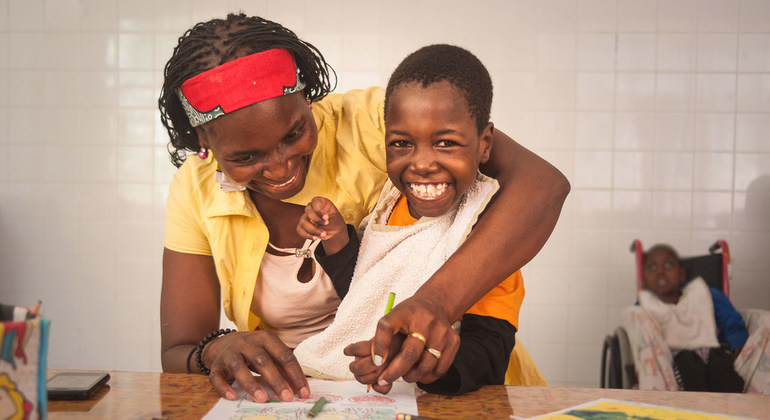With 181 State Parties, the Convention on the Rights of Persons with Disabilities is among the world’s most widely ratified human rights treaties and the 2030 Agenda for Sustainable Development makes a firm commitment to ensuring that persons with disabilities are not left behind in the international community’s quest for peace and prosperity on a healthy planet.
But wide gaps remain between these ambitious steps and the daily reality faced by the world’s estimated one billion persons with disabilities, some 80 per cent of whom live in developing countries where they are among the most marginalized in any crisis-affected community.
Barriers still exist; stigma fuels discrimination
“The number of persons with disabilities living in poverty and hunger is higher than, and in some countries double, that of the general population,” the Deputy Secretary-General said in her remarks to the opening ceremony of the Doha International Conference on Disability and Development.
She said that compared to the general population, persons with disabilities face far more barriers when accessing health care. “Globally, the percentage of persons with disabilities who are employed is half that of persons without disabilities,” she said, adding that they are also less likely to attend school and complete primary education.
In all regions, stigma faced by persons with disabilities abounds, compounded by a lack of understanding of their rights, and of the value of their contributions to society. Ms. Mohammed stressed that stigma continues to fuel systemic discrimination, with persons with disabilities denied equal access to education, the work force, health care and opportunities to participate in public life.
“And, for many persons with disabilities, in particular women and girls, the discrimination is multiplied,” she said.
More must be done to reverse ‘untenable situation’
“This situation is untenable. It goes against our collective commitment to human dignity, our obligations under international law and the strong business case for disability inclusion,” said Ms. Mohammed, declaring: “It is up to us – leaders from government, business, civil society, organizations of persons with disabilities, international organizations and others – to turn this situation around.”
Earlier in her remarks, the UN deputy chief noted “the tireless efforts of Her Highness Sheikha Moza bint Nasser”, whom hailed as “one of the most dedicated advocates we have for improving education around the globe and ensuring no one is left behind, especially persons with disabilities.”
Ms. Mohammed went on to recall that in September, UN Secretary-General António Guterres called for a Decade of Action to deliver the Sustainable Development Goals by 2030. And in doing so, he called on people everywhere to join a global movement for people and planet – for social inclusion, for climate action and for gender equality.
“In answer to this call, we must step up our collective performance on disability inclusion,” said Ms. Mohammed.
Four key areas of action
Setting out key areas where progress was necessary, the Deputy Secretary-General said that some countries still need to work harder to increase the availability of high-quality, timely and reliable data, disaggregated by disability, to inform their approaches to disability inclusion.
Further, resources are critical, and she said governments should be making disability inclusion a priority within their national budgets. “Existing resources have to be spent in a more disability-inclusive manner and more resources have to be allocated towards inclusion of persons with disabilities,” she said.
Ms. Mohammed also called for improved accessibility, which she underscored as “a precondition for the full inclusion and meaningful participation of persons with disabilities in our society.”
Finally, she urged support to persons with disabilities in conflict and humanitarian settings.
The United Nations is committed to assuming our responsibility to advance the rights of persons with disabilities in everything that we do – UN deputy chief Amina Mohammed
“This year we have seen several positive developments,” she explained, pointing to the UN Central Emergency Relief Fund (CERF), which for the first time, has persons with disabilities as a priority area; and the adoption by the UN Security Council in May of its first resolution on protection of persons with disabilities in armed conflict.
“Now we must work together to bring the commitments of these documents into action,” she said.
Ms. Mohammed said that through collaboration across UN Offices and Agencies, UN Country Teams, Regional Commissions and the UN Secretariat, practical assistance and training materials have been prepared and delivered to countries in Africa, Asia, Eastern Europe and Latin America to help navigate the challenges faced by persons with disabilities.
This past June, the Secretary-General launched the first-ever United Nations Disability Inclusion Strategy, a framework for action by the UN System. “The Strategy is our commitment to persons with disabilities – establishing the foundation for the systemic and sustainable change we need,” said Ms. Mohammed, explaining that it calls for action in four core areas of responsibility: leadership, strategic planning and management; inclusiveness; programming; and organizational culture.
The international community has made many advances in recent years in terms of disability inclusion. “But we have much more to do. As we look ahead to the Decade of Action, all of you have an essential role to play.”



